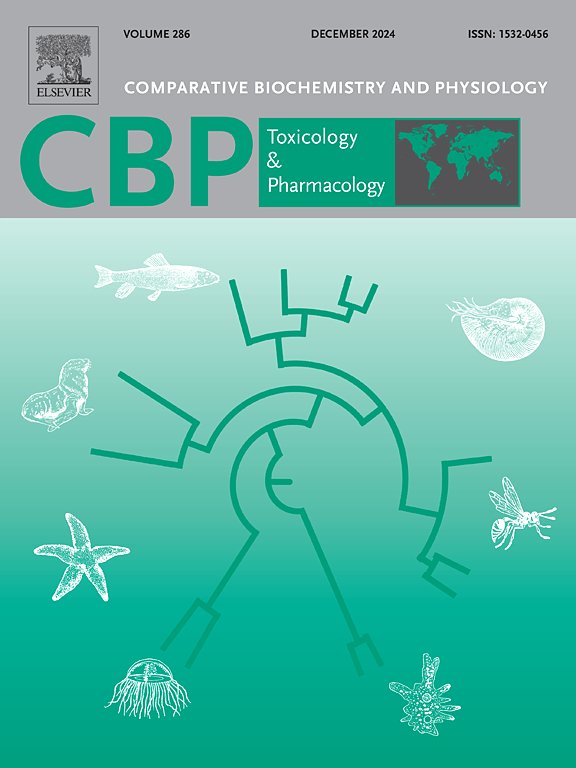Antimicrobial activity and immunomodulation of four novel cathelicidin genes isolated from the tiger frog Hoplobatrachus rugulosus
IF 3.9
3区 环境科学与生态学
Q2 BIOCHEMISTRY & MOLECULAR BIOLOGY
Comparative Biochemistry and Physiology C-toxicology & Pharmacology
Pub Date : 2024-12-20
DOI:10.1016/j.cbpc.2024.110091
引用次数: 0
Abstract
Cathelicidin is a family of antimicrobial peptides in vertebrates that plays an important role in resistance and immunization against pathogenic microorganisms. In the present study, the full-length cDNA sequences of four novel cathelicidins (cathelicidin-1 to cathelicidin-4) in the tiger frog Hoplobatrachus rugulosus, encoding 153, 188, 132, and 160 amino acids, respectively, were firstly cloned by rapid amplification of the cDNA ends (RACE) technique. Sequence comparison and phylogenetic tree analysis indicated that the structures of the four cathelicidins are highly diverse. Afterwards, the tissue distribution profiles and antimicrobial patterns of cathelicidins in H. rugulosus were determined by real-time PCR. The four cathelicidins showed tissue-specific distribution patterns in the healthy frogs, and the transcriptional levels of cathelicidins exhibited a tissue- and time-dependency profile in the frogs challenged with pathogenic bacteria Aeromonas hydrophila for 72 h. The synthetic peptides of cathelicidin-1 and cathelicidin-2 exhibited broad-spectrum in vitro antimicrobial activity, and cathelicidins exerted antimicrobial activities through excessive induction of reactive oxygen species and direct disruption of the microbial membrane structure. In addition, the intraperitoneal injection of cathelicidin proteins significantly increased the marine medaka Oryzias melastigma resistance to bacterial challenges. The existence of multiple cathelicidins, their distinct tissue distribution patterns, and the inducible expression profiles suggest a sophisticated, highly redundant, and multilevel network of antimicrobial defense mechanisms in tiger frogs. This study provides evidence that cathelicidins have antimicrobial and immunomodulatory activities, and cathelicidins derived from H. rugulosus have potential therapeutic applications against pathogenic infections in aquaculture.

虎蛙四种抗菌肽新基因的抑菌活性及免疫调节作用。
抗菌肽是脊椎动物的一个抗菌肽家族,在对病原微生物的抗性和免疫中起重要作用。本研究首次利用RACE技术克隆了虎蛙Hoplobatrachus rugulosus中4个新的抗菌肽(cathelicidin-1 ~ cathelicidin-4)的全长cDNA序列,分别编码153、188、132和160个氨基酸。序列比较和系统进化树分析表明,4种抗菌肽具有高度的多样性。随后,采用实时荧光定量PCR技术测定了抗菌肽在rugulosus体内的组织分布特征和抗菌模式。这四种抗菌素在健康青蛙中表现出组织特异性分布模式,在感染致病菌嗜水气单胞菌72 h的青蛙中,抗菌素的转录水平表现出组织依赖性和时间依赖性。合成的抗菌肽cathelicidin-1和cathelicidin-2具有广谱的体外抗菌活性,抗菌肽通过过度诱导活性氧和直接破坏微生物膜结构发挥抗菌活性。此外,腹腔注射cathelicidin蛋白可显著提高海洋米藻(Oryzias melastigma)对细菌攻击的抵抗力。多种抗菌肽的存在、其不同的组织分布模式和诱导表达谱表明,虎蛙体内存在一个复杂的、高度冗余的、多层次的抗菌防御机制网络。本研究证明了抗菌肽具有抗菌和免疫调节活性,并且从rugulosus中提取的抗菌肽具有潜在的治疗水产养殖致病性感染的应用前景。
本文章由计算机程序翻译,如有差异,请以英文原文为准。
求助全文
约1分钟内获得全文
求助全文
来源期刊
CiteScore
7.50
自引率
5.10%
发文量
206
审稿时长
30 days
期刊介绍:
Part C: Toxicology and Pharmacology. This journal is concerned with chemical and drug action at different levels of organization, biotransformation of xenobiotics, mechanisms of toxicity, including reactive oxygen species and carcinogenesis, endocrine disruptors, natural products chemistry, and signal transduction with a molecular approach to these fields.

 求助内容:
求助内容: 应助结果提醒方式:
应助结果提醒方式:


